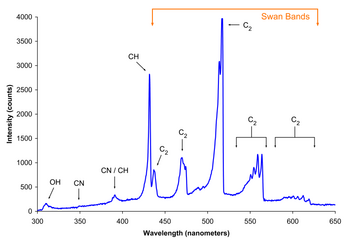
Swan bands are a characteristic of the spectra of carbon stars, comets and of burning hydrocarbon fuels. They are named for the Scottish physicist William Swan, who first studied the spectral analysis of radical diatomic carbon (C2) in 1856.
Swan bands consist of several sequences of vibrational bands scattered throughout the visible spectrum.
See also
References
- R.C. Johnson (1927). "The structure and origin of the Swan band spectrum of carbon". Philosophical Transactions of the Royal Society A. 226 (636–646): 157–230. Bibcode:1927RSPTA.226..157J. doi:10.1098/rsta.1927.0005.
- W.E. Pretty (1927). "The Swan band spectrum of carbon". Proceedings of the Physical Society. 40 (1): 71–78. Bibcode:1927PPS....40...71P. doi:10.1088/0959-5309/40/1/313.
- W. Swan (1857). "On the prismatic spectra of the flames of compounds of carbon and hydrogen". Transactions of the Royal Society of Edinburgh. 21 (3): 411–430. doi:10.1017/S0080456800032233. S2CID 98339461.
- Robert B. King (1948). "Relative Transition Probabilities of the Swan Bands of Carbon". Astrophysical Journal. 108: 429. Bibcode:1948ApJ...108..429K. doi:10.1086/145078.
This astrophysics-related article is a stub. You can help Misplaced Pages by expanding it. |
This spectroscopy-related article is a stub. You can help Misplaced Pages by expanding it. |